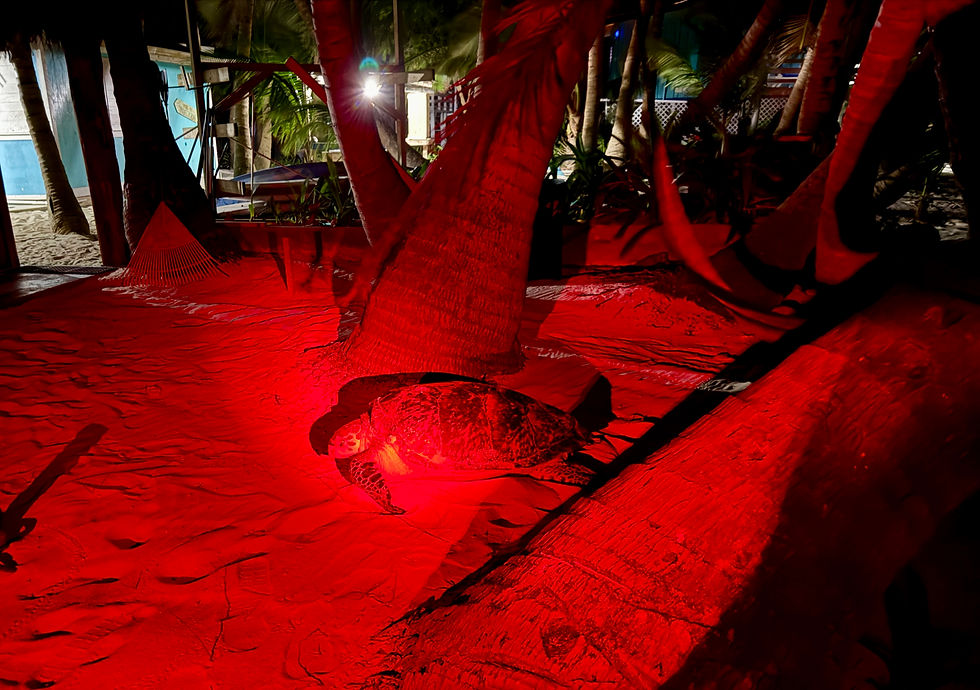When the Island Belonged to Her: A Hawksbill Encounter in Belize
- Nirvana Ramos

- Jun 13
- 3 min read
In honor of Hawksbill Turtle Day (June 13) and World Sea Turtle Day (June 16)

We didn’t go to Ranguana Caye for the sea turtles.
By the final week of May, most travelers have already left Belize, seeking cooler nights and drier air before the rainy season returns. But we had chosen the tail end of the dry season on purpose. It’s quieter. Less crowded. More local. And still full of wonder — even if you don’t expect it.
We knew, from years of travel, that sea turtle nesting season in Belize begins in June. And even then, sightings are never guaranteed. So while we carried a quiet hope, we didn’t plan our trip around it. We were there for slow sunsets, Caribbean waters, and easy nights under strings of soft café lights.
That’s what made it all the more extraordinary.
One evening, just after dinner, a shadow moved through the sand. At first, it didn’t register. Then someone whispered, “Is that a turtle?” And suddenly, everything stilled.
A hawksbill sea turtle — one of the most endangered species in the world — had come ashore. But she didn’t follow the expected route along the edge of the beach. She made her way directly through the center of the island, between the hammocks, under the palms, and right past the tables where we’d just finished eating.
There was no announcement. No warning. Just her.
We all moved — quietly, instinctively — out of her way. Though we were guests of the island that night, it was clear whose space this truly was. Her path mattered more than ours.
We tried to be silent, but the wonder was too much. People whispered.
“What kind is she?”“She’s beautiful.”“Shhh…”
Stillness fell again as she wandered beyond the lit dining area and out toward the far side of the island. We turned off the bright lights and switched to red-light torches, the kind used by conservation teams and respectful visitors to avoid disturbing sea turtles at night.
She kept moving, undeterred, until she found her spot in the sand. And then she began to dig.

No itinerary could have promised this. No travel brochure would have dared.
It was a moment that belonged to the wild — and we were simply lucky enough to witness it.
Why It Matters
Both Hawksbill Turtle Day (June 13) and World Sea Turtle Day (June 16) shine a spotlight on the fragile magic of these ancient mariners. Once hunted for their beautiful shells, hawksbills are now critically endangered — and sightings, especially of nesting females, are rare and precious.
Belize remains one of the most important nesting sites for hawksbills in the western Caribbean, particularly in the protected cayes off the southern coast. Conservation efforts are making a difference, but these creatures still need space, safety, and awareness to survive.
At Exploring Earth Together, we don’t offer wildlife as a guarantee. But we do create space for the unexpected — with slow travel, small groups, and a deep respect for the rhythms of the places we visit.

How to Travel Responsibly During Turtle Season
If you’re lucky enough to visit Belize between June and September, you may be entering sea turtle nesting season. Here’s how to be part of the solution:
Use red lights at night near the beach, especially from dusk to dawn.
Don’t approach or touch turtles, even if they seem calm.
Avoid flash photography and keep noise to a minimum.
Watch your step — nests are often buried and unmarked in the sand.
Support conservation groups doing the on-the-ground work to protect hatchlings.
And most importantly: be patient. These moments can’t be scheduled. But if you’re open to the pace of nature, you just might find yourself witnessing something unforgettable.
Travel. Relax. Play. Respect.
We weren’t expecting her.
But we’ll never forget her.
Join us this November through June — during Belize’s most peaceful and wildlife-filled season — for curated small-group journeys that give nature the space to surprise you.



Comments